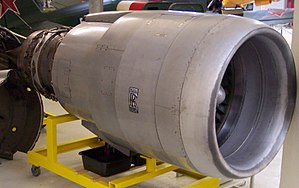Rolls-Royce/SNECMA M45H
| M45H | |
|---|---|

| |
| M45H engine on display | |
| Type | Turbofan |
| National origin | United Kingdom / France |
| Manufacturer | Rolls-Royce/SNECMA |
| First run | 1970 |
| Major applications | VFW-Fokker 614 |
| Developed from | SNECMA M45 |
The Rolls-Royce/SNECMA M45H is an Anglo-French medium bypass ratio turbofan produced specifically for the twin-engined VFW-Fokker 614 aircraft in the early 1970s.
The design was started as a collaborative effort between Bristol Siddeley and SNECMA.[1]
Design and development[edit]

The VFW 614 was designed to operate over short sectors with up to a dozen flights a day. The engines were optimized for 30-minute sectors at a cruise altitude of 21,000 feet at Mach 0.65. Only a few minutes would be spent at the cruise rating and most of the flight would be at the higher climb rating or at a descent setting. The engine had a low turbine entry temperature and comparatively low rotational speed.[2]
The engine was designed to be uprated without drastic redesign. Three options were water injection (+10% thrust), improved HP turbine (+10% thrust), addition of a zero-stage to the LP compressor (+25% thrust).[2] The M45H-01 was to have a thrust-specific fuel consumption (TSFC) of 12.91 grams per kilonewton per second (0.456 pounds per pound-force per hour).[3]
The engine was developed at the time of the Rolls-Royce bankruptcy which resulted in delays in developing the engine.[4]
Variants[edit]

- M45F
- Civil low bypass turbofan 7,915 lbf (35.21 kN) for take-off.[5]
- M45G
- Military low bypass turbofan 13,200 lbf (58.72 kN) for take-off, wet.[5]
- M45H
- Civil medium bypass turbofan 7,880 lbf (35.05 kN) for take-off, wet.[5]
- RB.410
- Rolls-Royce designation for the M45SD-02 geared turbofan
- M45SD-02
- A derivative of the M45H-01 turbofan, designed[when?] to demonstrate ultra-quiet engine technologies, needed for STOL aircraft operating from city centre airports. A geared, variable pitch fan, replaced the first stage of the low pressure (LP) compressor. A modest fan pressure ratio, consistent with the high bypass ratio, meant a low fan tip speed could be employed. A low hot jet velocity was another major design feature. In reverse thrust, intake air entered the bypass duct, via a gap in the cold nozzle outer wall, and went through the fan, to be expelled through the intake. A small proportion of the bypass duct air entered the IP compressor, via a special diverter valve, to sustain the gas generator. Reverse thrust was obtained by the fan going through fine (rather than feather) pitch. Engine testing took place in the mid 1970s. The chief engineer of this project was David McMurtry, co-founder and Chairman of Renishaw PLC. After the prototype engine was stored,[when?] it was given to McMurtry for safe keeping at the New Mills site.[citation needed]
Engines on display[edit]

Rolls-Royce/SNECMA M45H engines are on display as part of the aero engine collection at the Royal Air Force Museum Cosford and the Musée aéronautique et spatial Safran. Additionally, an engine, with its cowl and pylon, is displayed at the Deutsches Museum Flugwerft Schleissheim; this museum also displays a VFW-614, which has two engines mounted.
Specifications (M45H Mk.501)[edit]
Data from Jane's All the World's Aircraft 1971-72.[6]
General characteristics
- Type: Turbofan
- Length: 2,600 mm (102.4in)
- Diameter: 909 mm (35.8 in)
- Dry weight: 673 kg (1,483 lb)
Components
- Compressor: 5-stage intermediate pressure and 7-stage high-pressure axial compressor with a single-stage fan
- Bypass ratio: 2.85:1[7]
- Combustors: Annular with 24 vapourising burners
- Turbine: 3-stage low pressure and single-stage high pressure turbines
- Fuel type: Aviation kerosene (JetA-1 typically)
- Oil system: pressure return system at 207 kPa (30 psi)
Performance
- Maximum thrust: 7,300 lbf (32.4 kN[8])
- Overall pressure ratio: 16.5:1
- Air mass flow: 104 kg/s (230 lb/s)
- Thrust-to-weight ratio: 4.9:1
See also[edit]
Related development
Comparable engines
Related lists
References[edit]
- ^ "Bristol Siddeley engines". Flight International. 6 January 1966. p. 28. Archived from the original on 10 November 2013.
- ^ a b "M45H: Power for VFW-Fokker 614". Flight International. 18 April 1974. pp. 485–488. Archived from the original on 4 March 2016. Includes engine cutaway.
{{cite magazine}}: External link in|postscript= - ^ Bose, T. (2012). Airbreathing propulsion: An introduction (PDF). Springer Aerospace Technology. Springer Science+Business Media, LLC. p. 288. doi:10.1007/978-1-4614-3532-7. ISBN 978-1-4614-3531-0.
- ^ Swanborough 1971, p.371.
- ^ a b c Wilkinson, Paul H. (1966). Aircraft engines of the World 1966/77 (21st ed.). London: Sir Isaac Pitman & Sons Ltd. pp. 165–167.
- ^ J W R Taylor 1971,p.650.
- ^ "614: VFW's jet feederliner" (PDF). Flight International. 4 November 1971. p. 730. Archived from the original (PDF) on 6 March 2016.
- ^ "Archived copy" (PDF). Archived from the original (PDF) on 6 June 2011. Retrieved 21 October 2007.
{{cite web}}: CS1 maint: archived copy as title (link)
Further reading[edit]
- Davies, D. G. M.; Miller, D. C. (19–20 May 1976). A variable pitch fan for an ultra quiet demonstrator engine. 1976 Spring Convention: Seeds for Success in Civil Aircraft Design in the Next Two Decades. Royal Aeronautical Society. pp. 1–18.
- Stevens, James Hay (12 August 1971). "Rolls-Royce design for quieter airliners". New Scientist and Science Journal. Vol. 51, no. 764. pp. 376–377. ISSN 0369-5808.
- Swanborough, Gordon. Air Enthusiast, Volume One. London: Pilot Press, 1971. ISBN 0-385-08171-5.
- Wright, G. H.; Russell, J. G. (18 March 1980). "The M.45SD-02 variable pitch geared fan engine demonstrator test and evaluation experience". The Aeronautical Journal of the Royal Aeronautical Society. 84 (836) (published September 1980): 268–277. doi:10.1017/S0001924000031304. ISSN 0001-9240. OCLC 8272365305. S2CID 245674662.
External links[edit]
- Stol Fans from Dowty a 1971-01-21 Flight International article
- Rolls-Royce/SNECMA promotional film about the M45H engine on YouTube
